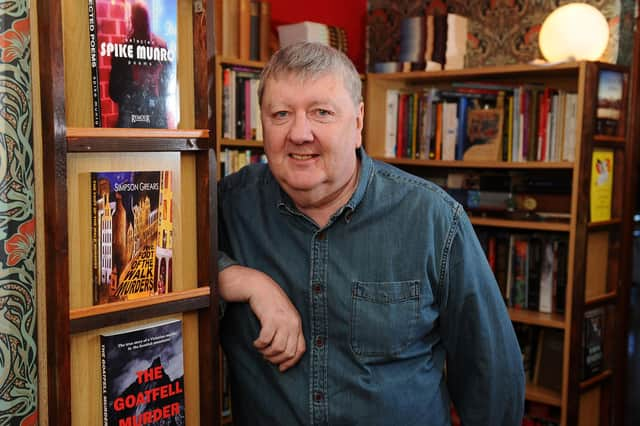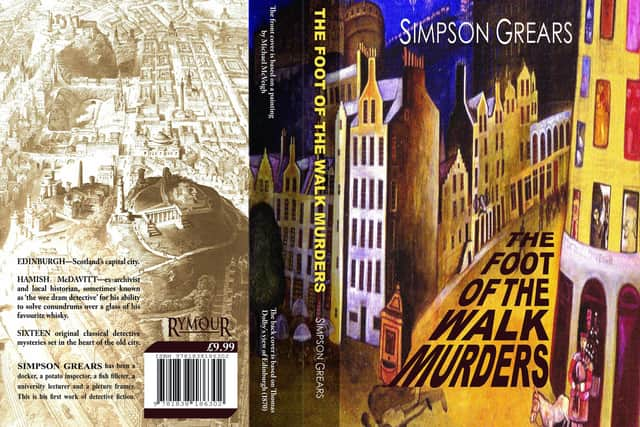The Foot of the Walk Murders, by Simpson Grears, Pt 1: The Edinburgh Ripper


Chief Superintendent Robert Ord, who had grown rather corpulent in the years approaching his retirement, had puffed and panted his way up three flights of stairs to Hamish McDavitt’s top floor flat in Royal Terrace, but on arrival he had been amply rewarded with both a hot cup of Assam tea and a dram of a nice 15-year-old Scapa that Hamish had purchased from a limited edition cask at the Malt Whisky Society.
As they sat in comfort by the balconied windows overlooking a cold and grey day to the north over the Firth, the conversation eventually got round to Ord’s keenest interest – the history of criminology.
Advertisement
Hide AdAdvertisement
Hide Ad‘Have you read the new book by Timothy Peers-David, The True Story of the Edinburgh Ripper?’


‘Ah,’ said Hamish, going across to his desk and retrieving a medium thickness volume in a fairly lurid dust jacket. ‘Strange that you should mention it. In fact, it has just arrived – a gift from the author. I met him some time ago, when I was looking into the affair of the Halfway House haunting. I’ve glanced at it, but I haven’t read it in any detail yet.’
He put the book down on the barley twist gate-leg dining table in the centre of the room that, in truth, was seldom used for dining and was usually covered with books and papers.
‘However,’ Hamish continued, ‘I believe that the author has discovered some new evidence and come up with a startling new theory.’
Advertisement
Hide AdAdvertisement
Hide Ad‘Well, new theories seem to be de rigeur for these young authors. And there isn’t much new evidence – at least not that I would credit a jot. We simply agreed to give him access to the old declassified police files. As usual, there isn’t much attempt to give credit to good old-fashioned police work. In my view the original investigator of the case, Inspector John Lambie, solved the crime years ago, that’s why, in a way, it has never been studied as much as some more sensational cases.’
This was true, as Hamish himself knew The ‘Edinburgh Ripper’ murders had pre-dated the infamous Whitechapel murders – also known as the Jack the Ripper murders – and had originally been known as the Foot of the Walk murders having taken place in or around the north end of Leith Walk, colloquially known as ‘the foot of the walk’.
The ‘Ripper’ appellation had only been added years later. Yet, despite the sensational nature of the crimes, their impact on the popular consciousness had been fairly limited, perhaps because the case had been solved and the perpetrator – a Lascar sailor known as Johnny Monkey – having committed suicide, had never gone to trial. It was probably also the case that the conservative Edinburgh press, with a reputation as more staid and serious than, say, the London newspapers with their gaudy illustrations and lurid supplements, had failed to publicise the murders properly, as well as completely ignoring their prurient sexual nature.
The book in question covered the best known facts of the case thoroughly and gave a very atmospheric description of the Edinburgh of 1886: ‘Edinburgh in 1886: the Edinburgh of Stevenson’s Jekyll and Hyde. The pest-ridden slums of the old town living hand in hand with the lavish terraces of the New Town. A busy birling city, gentlemen in their fine capes and canes, their servants, workmen of all appellations all jostling to do their business in the sometimes dusty, sometimes muddy streets.
Advertisement
Hide AdAdvertisement
Hide AdIt was a city that had reached its apogee, and was now dwarfed by its rapacious neighbour to the west, force fed with Irish immigrants, hot steel, docks and railyards. But Edinburgh was still the Athens of the North and still Scotland’s capital, and more than that, the capital of North Britain, its premier citizens aligning themselves with a unionist rather than a nationalist view of its place in the great British Empire... ’
‘It was the year of the Great Exhibition, wasn’t it?’ asked Hamish.
‘The International Exhibition of Science, Art and Industry on the Meadows,’ elaborated Ord. ‘My parents always pointed out the entrance, the whalebone arch in Meadow Walk, when we went on walks after Sunday School. It’s the only bit that still stands, although the whole thing must have been very impressive in its time.’
‘There was a whole street, square and precinct built called ‘Old Edinburgh’ based on buildings that had been lost at that time. It’s difficult for us to realise. We think that Edinburgh is old enough already, but some of the Old Town was being demolished then! It was preserved in the drawings of Bruce Home, but also in the reconstructed village Edinburgh built in the Meadows. There’s a model in Huntly House, and we have the photographs of Marshall Wane to remind us.’
Hamish paused and thought for a moment.
Advertisement
Hide AdAdvertisement
Hide Ad‘In fact, I have them here’, he said. He stepped over to a bookcase and brought out an album of postcards from a drawer.
He presented Ord with a leather-bound album containing about 20 postcards, some in sepia, some colour tinted, some plain, and some with an inscription or a few words written on the front, as was the custom in those days.
‘These are Marshall Wane’s photographs of Old Edinburgh: The House of Mary o’ Guise, Sympson’s Close, the Old Tolbooth, the Scottish Mint, etcetera. Wane took them for the exhibition, but he kept the negatives. Fifteen years later the postcard was invented. So he recycled them all as postcards and made himself a few bob. It’s a very strange set, I find. It’s supposedly ‘old’ Edinburgh, yet all these buildings were built specially for the exhibition and demolished immediately afterwards. It’s as artificial as a Disney stage set!’
Tomorrow: Violent deaths rock Leith and Edinburgh